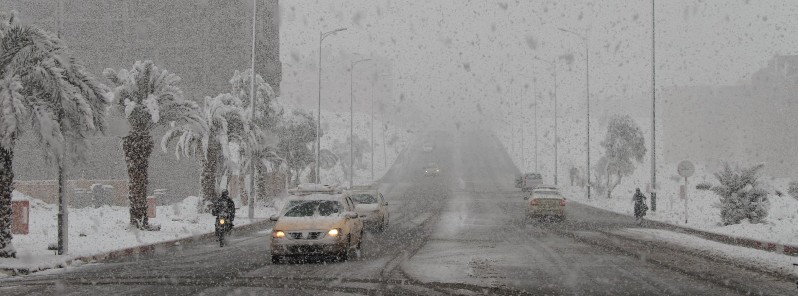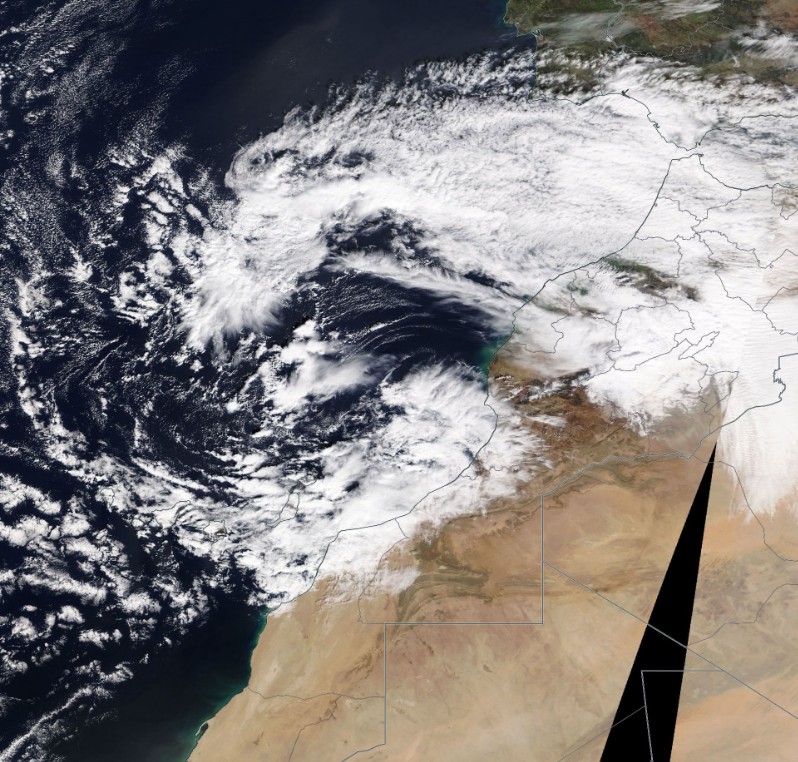First snow in 50 years hits southern Morocco, exceptional snowfall paralyzes the country

Following unprecedented road conditions across Morocco on January 20, 2018, when 5 000 km (3 100 miles) of roads were closed due to what authorities described as 'exceptional' snowfall, heavy snow arrived to the country's southern regions on January 29, for the first time in 50 years.
To address the unprecedented road conditions earlier this month, the Moroccan Ministry of Equipment, Transport, and Logistics mobilized 117 snow plows, acknowledging that the blockages disproportionally affected rural areas and promising huge investment in rural roads. The minister also made a public reminder that, before getting behind the wheel, Moroccans can use the application “MaRoute” to access the most recent information about the state of the roads across the country, the Morocco World News reported.
As if that wasn't enough, an unusually heavy snowfall started affecting Morocco's southern regions on January 29, after several decades of extremely dry weather. The snowfall is currently affecting Ouarzazate (gateway to the Sahara Desert), Taroudant and even Zagora, which hasn't experienced snowfall since 1968.
Ouarzazate snow on January 29, 2018. Credit: Ouarzazate Online


First snow in Zagora since 1968 – January 29, 2018. Credit: 04 TV
Head of communications at the National Meteorological Directorate blamed the cold weather and southern snow on the influence of a very low pressure area, adding that similar weather (cold, snow and rainfall) should be expected across the country at least until Thursday, February 1.


Low pressure area over Morocco on January 29, 2018. Credit: NASA Terra/MODIS
From 06:00 local time January 28 to 06:00, January 29, Ouarzazate's city center recorded between 1 and 5 cm (0.39 – 1.96 inches) of snow, while Amzri and Imdrasse (surroundings) saw between 22 and 30 cm (8.66 – 11.8 inches) and between 10 and 20 cm (3.93 – 7.87 inches), respectively. Minimum temperatures in this region are expected between -4 and 1 °C (24.8 – 33.8 °F) and maximum between 5 and 9 °C (41 – 48.2 °F).
Weather authorities said the cold weather will particularly affect the Rif, Oriental, plateaus of phosphate and Oulmes, the Saiss and the interior plains. Meanwhile, the provinces of Boulmane, Ifrane, Khénifra, Midelt, Beni Mellal, Azilal, Errachidia, Tinghir, Ouarzazate, Al Haouz and Chichaoua will see snowfall.
Featured image: Snow in Ouarzazate, Morocco on January 29, 2018. Credit: Ouarzazate Online

Quote: “The first snow in 50 years affects the south of Morocco, an exceptional snow paralyzes the country.”
Reasons: There are many. Warming increased:
Evaporation of the ocean. The evaporation of the ocean became more because of the temperature increase. With the growth of temperatures, the velocities of the molecules of water evaporating from the ocean increase. They are thrown into the higher layers of the atmosphere, and are cooled by the height. Eliminate due to the restoration of rivers, and the increase in green mass: grass, shrubs and trees. The green mass covers the open soil with a green carpet. In this case we get: The temperature in the open area was 40 degrees. After planting green mass – roughly 20. Evaporation decreased by 50%. Hence, we get two magnificent results:
Closed green areas do not evaporate into the atmosphere 50% moisture;
With each rain, the green areas will hide 50% of the rainwater under the green carpet, and do not evaporate it into the atmosphere.
Result:
Replenish rivers and lakes – and they are the best temperature stabilizer. When the cold front arrives, rivers and lakes give off heat. When a warm front comes in, they absorb it.
The green mass-preserved or new forests-extinguishes the winds and prevents them from carrying heat or cold over long distances.
Hence, if you start working in the commonwealth of Morocco – Algeria, or Morocco – and 4 more states, you can get tangible results in three years.
Reference: There are many more natural technologies working for the development of states, and they can also be used.
Sincerely, developer of environmental programs, Victor Rodin. Ukraine. (Khmelnitsky NPP). Tel. Kiev Star: 961336344. Addresses on the Internet: rodin.vik@yandex.ua, dorosydos@gmail.com.
— — —
Цитата: «Первый снег в 50 лет поражает юг Марокко, исключительный снегопад парализует страну».
Причины: Их много. Потепление увеличило:
Испарения океана. Испарений океана стало больше из-за роста температур. При росте температур, скорости молекул испаряемой из океана воды увеличиваются. Они выбрасываются в более высокие слои атмосферы, и больше охлаждаются за счёт высоты. Устраняются за счёт восстановления рек, и прироста зелёной массы: травы, кустарников и деревьев. Зелёная масса закрывает открытые почвы зелёным ковром. В этом случае получаем: Температура на открытом участке была 40 градусов. После посадки зелёной массы – грубо 20. Испарения уменьшились на 50%. Отсюда, получаем два великолепных результата:
Закрытые зелёной массой участки не испарят в атмосферу 50% влаги;
При каждом дожде озеленённые участки будут прятать под зелёным ковром 50% дождевой воды, и не испарять его в атмосферу.
Результат:
Пополнятся реки и озёра – а они наилучший стабилизатор температуры. При приходе холодного фронта – реки и озёра отдают тепло. При приходе тёплого фронта – поглощают его.
Зелёная масса – сохранённые или новые леса – гасят ветра, и не дают им переносить тепло или холод на большие расстояния.
Отсюда, если начать работать в содружестве Марокко – Алжир, или Марокко – и ещё 4 государства, можно через три года получить ощутимые результаты.
Справка: Есть ещё много природных технологий, работающих на развитие государств, и их тоже можно использовать.
Wow!